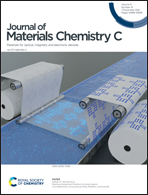Effects of polarized light on the optical and self-oscillation behaviors of liquid crystal network polymers†
Abstract
The phenomenon of self-oscillation is abundant in nature, which often occurs in response to various environmental stimuli. The most common stimuli for these processes are heat and light. Oscillations based on bending are one type of self-oscillating phenomenon. In this study, the oscillation frequency and amplitude of liquid crystalline polymer network (LCN) structures with light are investigated. Due to the anisotropy of LCN, which originates from a specific orientation in the LCN surfaces, all studies are performed with polarized light to accurately determine the effect of different orientations of these networks on frequency and oscillation parameters. The different polarizations of light show different oscillating behaviors in terms of amplitude and frequency of the LCN oscillation. To investigate the factors affecting the amplitude and frequency, such as temperature and optical behaviors, the effect of increasing the power of the polarized light source on the behavior of these materials is evaluated.



 Please wait while we load your content...
Please wait while we load your content...